Picture the scene.
Like any sensible company, you’ve been investing in IT capabilities. There’s a fantastic system of apps. Everyone has access to the right hardware. And access to resources is seamless because of a proficient cloud-based system.
It sounds great – and for most users, it is! But under the bonnet, it’s a bit uglier.
For every essential app, there’s another one that no one uses. Cloud-based solutions help everything, but you’re paying for services beyond your requirement. And you’ve been dishing out iPhones to everyone who asks for one. Today, spending too much on your IT infrastructure is so easy.
Once you get started, you need to make your costs sensible. In this article, we’re going to help you understand how.
The article will start by discussing the meaning of IT cost reduction, then explain why making strategic cost savings is so important. We’ll introduce some key ideas for making savings. And at the end, we’ll offer suggestions for further advice on this challenging topic.
Before we get started, here’s one little note. This article emphasizes that you need to make strategic decisions about IT spending. If someone says you MUST outsource staff, you MUST adopt cloud infrastructure.
You MUST get cheaper hardware – they’re wrong. The answers are different for every company. You will sometimes need an extensive change management process to get it right.
What is IT cost reduction?
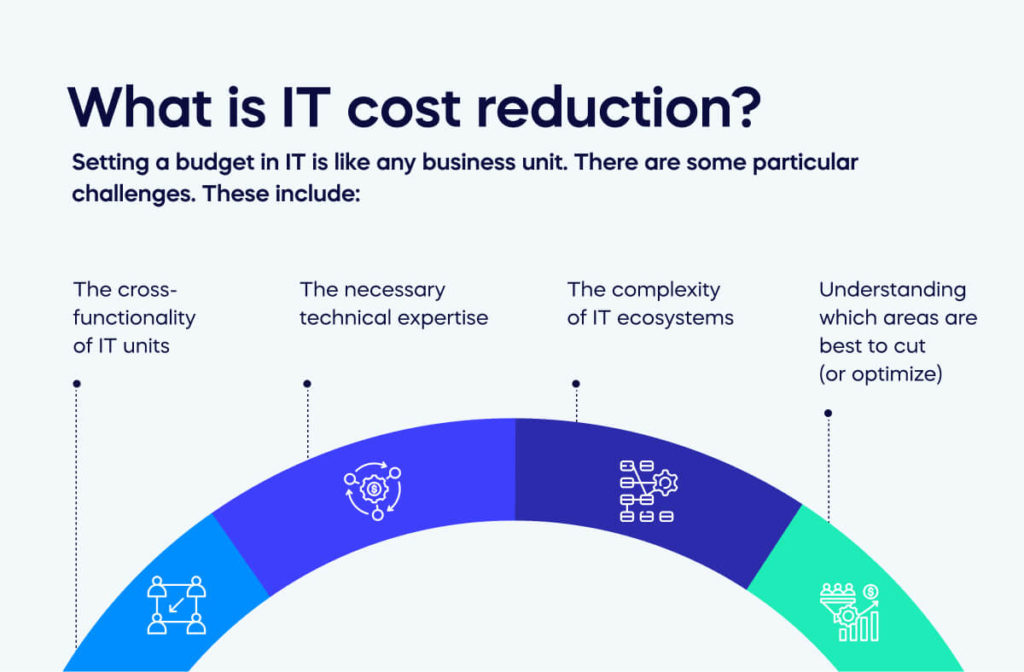
Cost reduction in IT is just one aspect of business cost reduction strategies. That is, it’s all about monitoring processes, identifying excessive expenditures, and implementing strategies to reduce expenses.
Setting a budget in IT is like any business unit. There are some particular challenges. These include:
- The cross-functionality of IT units.
- The necessary technical expertise
- The complexity of IT ecosystems
- Understanding which areas are best to cut (or optimize)
To balance all these aspects, IT leaders need a diverse skillset. They will need technical and financial sensitivity. But they must also be able to communicate effectively.
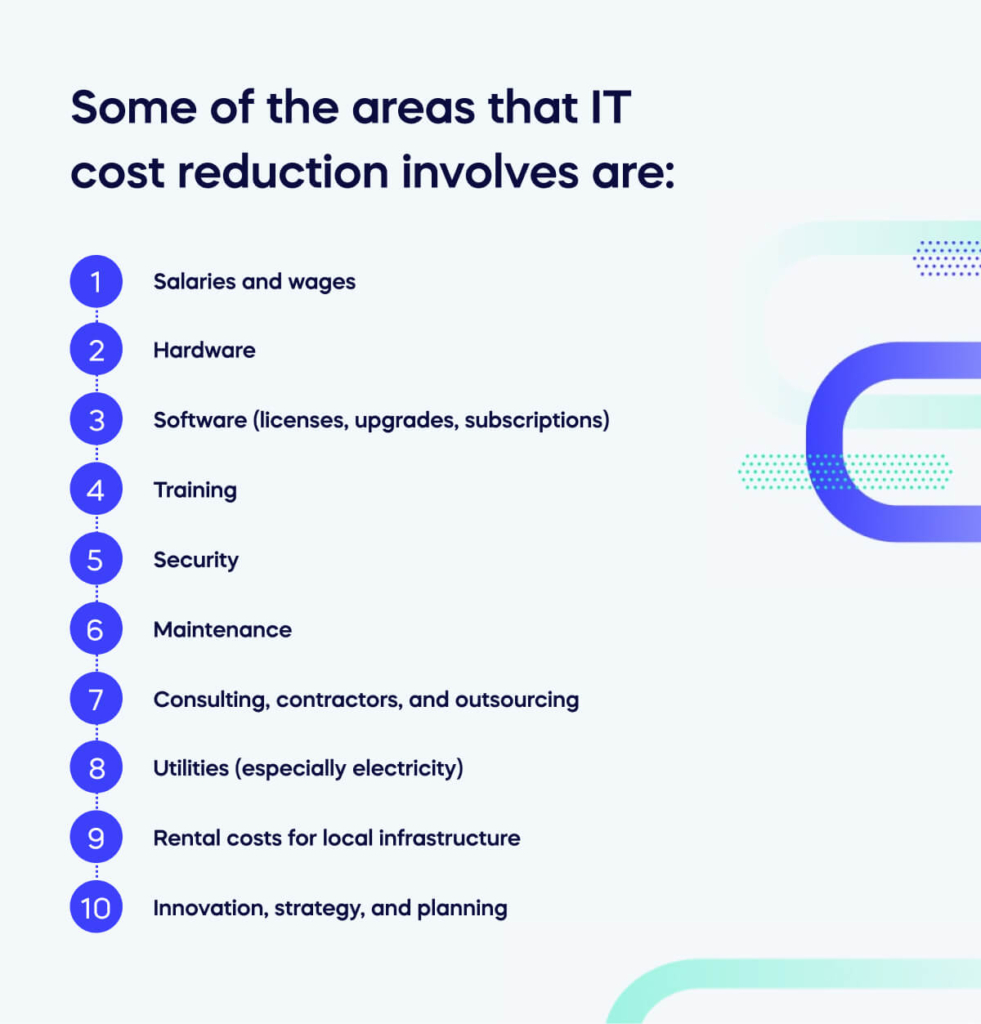
Some of the areas that IT cost reduction involves are:
- Salaries and wages
- hardware
- software (licenses, upgrades, subscriptions)
- Training
- Security
- Maintenance
- consulting, contractors, and outsourcing
- utilities (especially electricity)
- rental costs for local infrastructure
- Innovation, strategy, and planning
Some of these costs are flexible or negotiable. They depend on the number of users, the amount of use, and the precise functionalities offered. Flexibility is very useful for companies that are planning to grow and change. But it also means that IT managers must be attentive to their options.
Why is strategic IT cost reduction important?
Today, strategic cost reduction isn’t just a remedy for short-term problems. As a 2023 Knowledge at Wharton podcast described, businesses “are trying to free up resources and reinvest that money in the firm.”
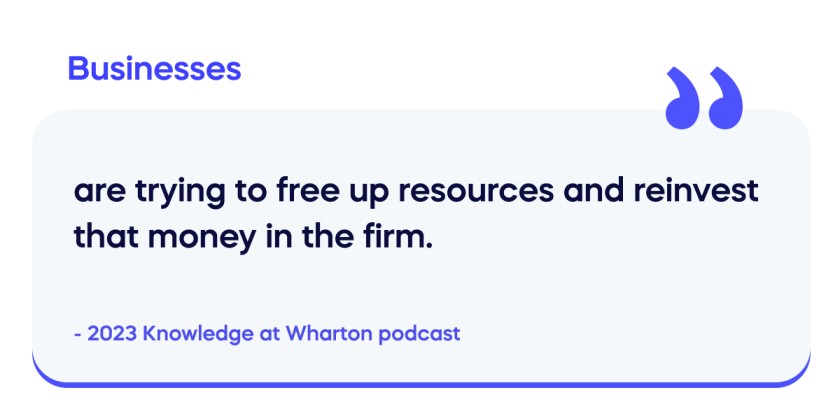
In today’s world of IT infrastructure, many costs can be difficult to monitor. Technology sprawl is one of the major reasons for this. IT spending can be spread thinly over the organization. A recent McKinsey analysis showed that a company with $5 billion in turnover might spend $250 million on data management. This spending isn’t concentrated in one location: it’s spread across the organization in unpredictable places.
In other words, monitoring exactly what’s going on is difficult. How can you tell if people are using every app effectively? How do we know what apps are essential and which could be replaced?
Get the Big Picture for your IT Cost Reduction
How will you be able to tell if your cost optimization strategy is fit for purpose? If nothing else, it must consider the major impacts of IT on a company. We can use three useful resources from Forrest, McKinsey, and Gartner for further guidance.
- Consult industry standards with Forrester. Forrester publishes unbiased accounts of relevant consulting agencies, including cloud cost management. Their reports are expensive but may provide answers that cannot be found elsewhere.
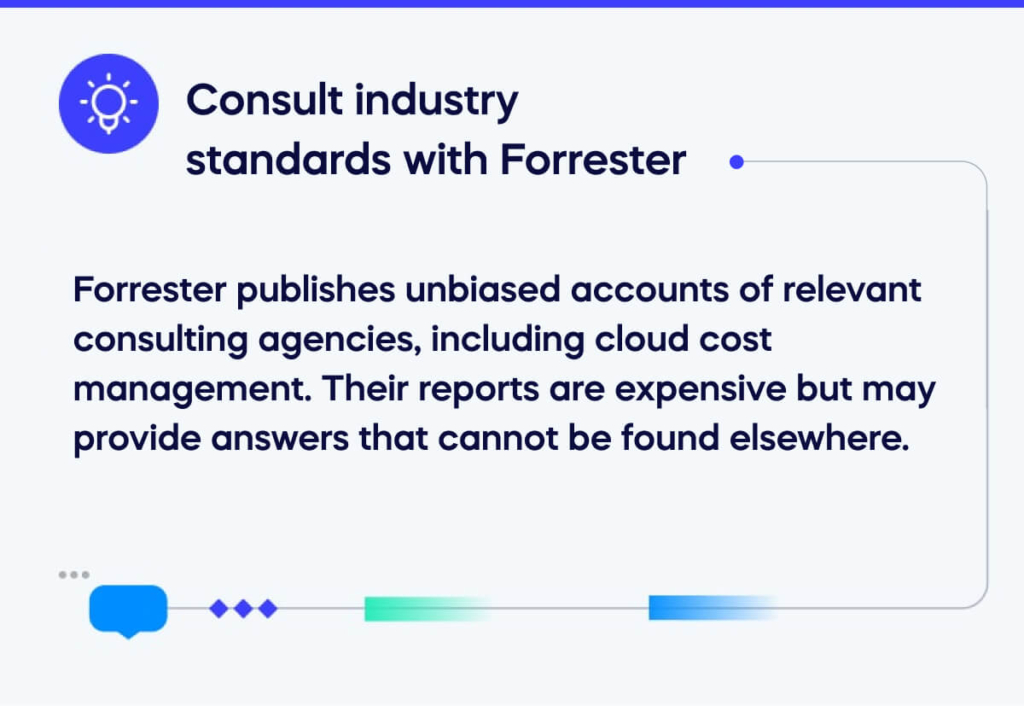
- Learn the big questions with McKinsey. A recent analysis from McKinsey suggested three primary questions for cost-cutting. They advise that you first understand all your cost-reducing techniques, take advantage of IT’s flexibility, and invest in business productivity. These simple steps show how you keep the business running effectively, even while cutting costs dramatically.
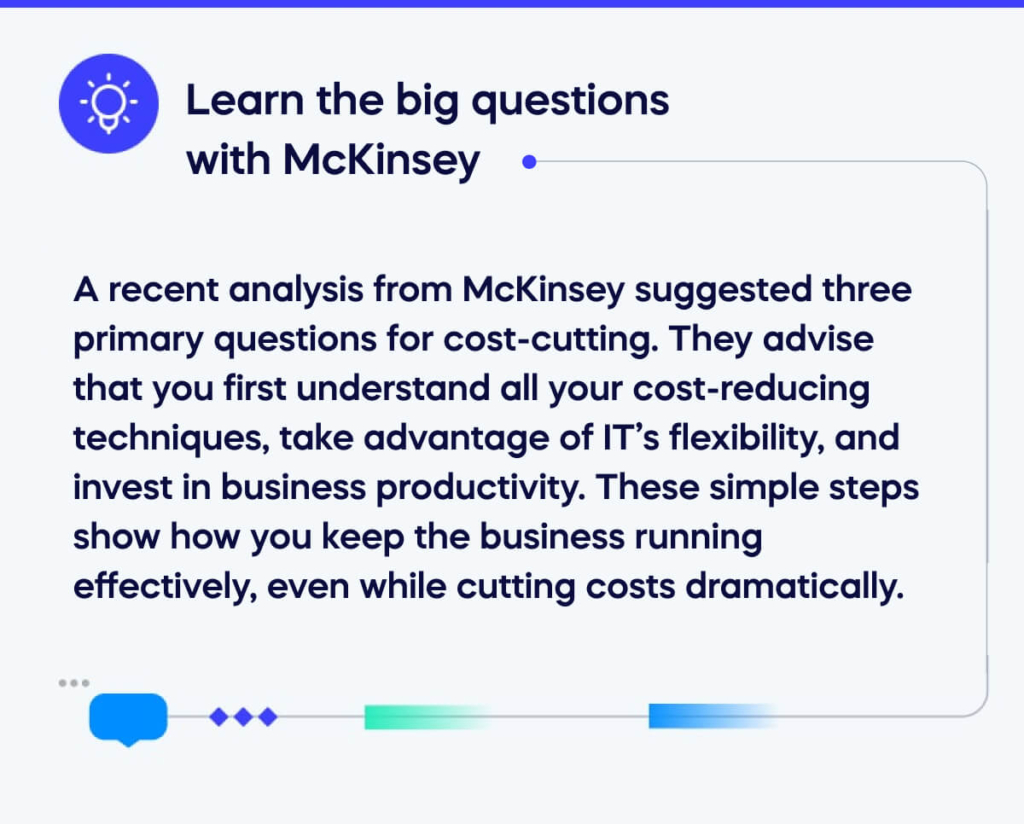
- Use Gartner’s cost optimization roadmap. Gartner’s simple roadmap from 2020 suggests several key steps for the process. They show how you must understand your current assets, seek opportunities, formulate the implementation, institutionalize the results, and monitor the outcomes.
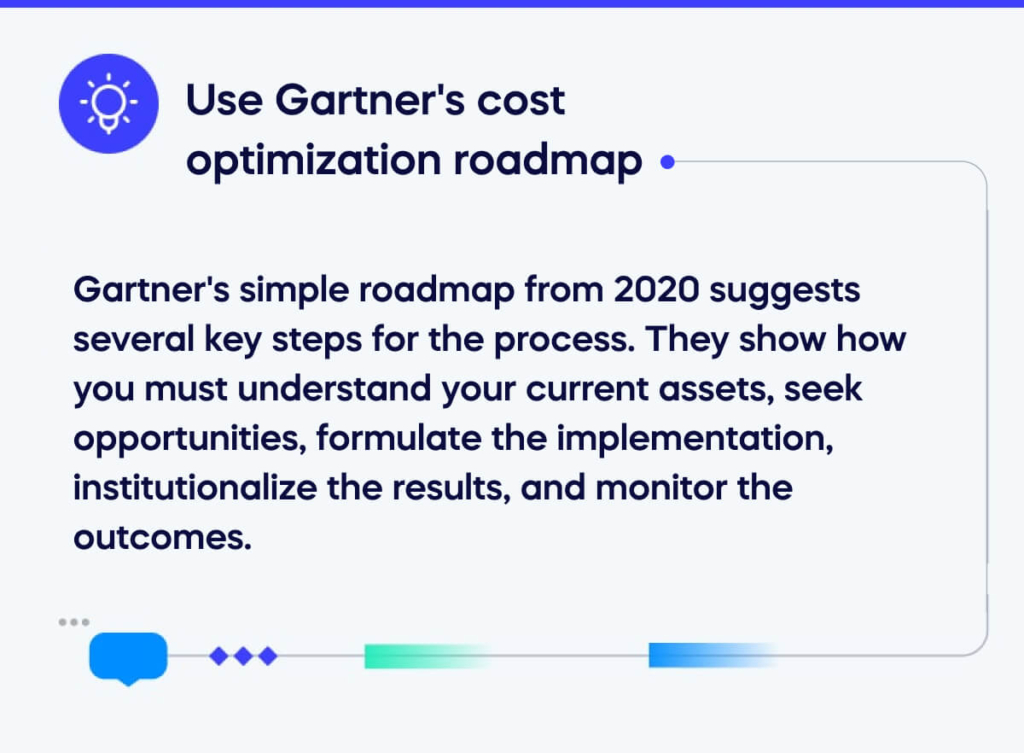
Now, this isn’t an advertising page for these consultancies. But anyone working on your IT cost reduction needs all the help they can get! e future.
IT cost reduction in 2023
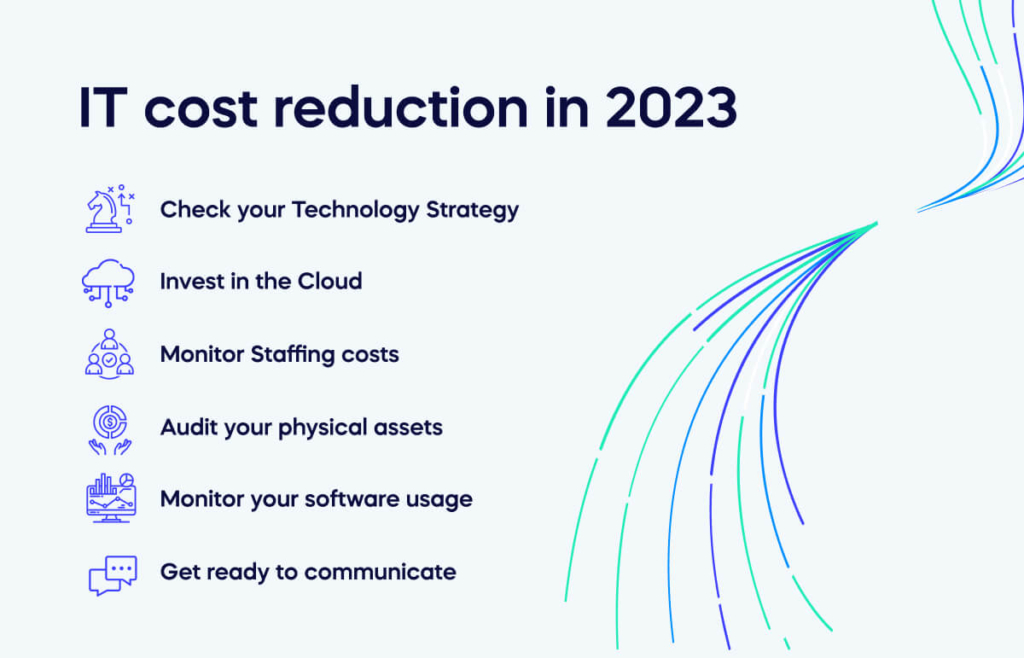
Now we’ve thought about the big picture – let’s think about some specific tasks that can help you reduce costs in your business’s IT services.
This year, it’s unlikely that your IT budget will get an upgrade. So let’s get started.
Check your Technology Strategy
If you don’t haven’t a thorough technology strategy, it’s time to get one.
Technology and business growth go hand-in-hand. A strong IT strategy should align with your organizational business goals.
The strategy document will be a fantastic way to see how your assets work together. It might show that IT can be easily scaled back: or it could be a good time to think about digital transformation projects that your company could implement.
Invest in the Cloud
Ten years ago, cloud computing was in its infancy. Every organization needs heavy site-based infrastructure to operate.
Now. cloud solutions offer a far easier way to build IT capabilities. With reduced maintenance costs, reduced energy costs, and lower hardware spending, it’s no wonder that many organizations are turning to the cloud for their operations.
Cloud solutions are also great for companies with plans to grow and develop. Your decision to go through a cloud transformation could have long-term benefits for business growth.
Monitor Staffing costs
If you want to cut costs urgently, it’s easy to forget that strong technology systems need specialist staff. Staff are expensive – so surely, reducing employees is an easy win?
However, you have to be very careful with staffing costs. As a 2020 BCG analysis puts it, “Reducing staff across the board today could hurt your ability to deliver services tomorrow.”
So when it comes to personnel costs, you could still consider other tactics. For example, you could consolidate vendors; bring third-party support in-house; or outsource support to cheaper geographies.
Audit your physical assets
A hardware audit can be an effective way for businesses to reduce IT costs by identifying outdated, underutilized, or unnecessary hardware.
The first step is to inventory and categorize all hardware assets based on age, condition, and usage. This allows you to analyze usage, energy efficiency, compatibility, and the total cost of ownership for each piece of hardware. Based on the output of the audit, businesses can consider replacing, upgrading, or reducing hardware to reduce costs.
By performing a hardware audit, businesses can identify areas to optimize their hardware resources, reduce maintenance costs, and achieve significant cost savings over time.
Monitor your software usage
It’s tough to keep track of software usage. But new technology, like digital adoption platforms, gives CIOs crucial information about how staff uses their software.
The data and analytics from a DAP are useful in several ways. They show leaders how to optimize their processes. The DAP identifies areas where additional training or support is needed.
Perhaps it’s counter-intuitive to suggest further investments as part of a cost-cutting task. But in the long run, gathering precise data will dramatically reduce the costs arising from inefficiencies.
Get ready to communicate
Like any change operation, some staff won’t be happy with IT cost reductions.
A CIO’s job is to explain all cost reductions clearly to staff. But in turn, they also need to listen to staff, understand their needs, and ensure that their solutions align with standard business processes.
The CIO might not understand the need for very specialist software, which only one or two people use. On the other hand, rank-and-file staff may not like giving up their extra devices.
You need to balance both sides: clear communication will ensure you achieve this.
Strategic IT Cost Reduction: Saving The Bottom Line
In conclusion, you can’t avoid spending money on IT. It’s an essential expense, and it’s difficult to imagine business growth without sensible technology investments. However, IT can be optimized, rationalized, and strategically deployed. The mission is not just to “save money” at all costs but to reduce costs in the right place.
One last idea we should mention. If you don’t know where you are wasting money, a digital adoption platform will show you where you are going wrong.


